Exercise is great for the human body and has many positive effects. We aren’t talking about the Ironman or a hundred-mile race, just regular consistent exercise like running, walking, or any form of exercise for about an hour.
In this article, we would like to talk about 1-month workout results before and after transformations and how exercise benefits your body. Let’s get started.
Jump to:
- Benefits of Working Out for Men and Women
- 1-Month Workout Results: Before and After Male Transformations
- 1-Month Workout Results: Before and After Female Transformations
- Factors Affecting Your 1-Month Workout Results Before and After
- Our Tips for Maximizing Your 1-Month Workout Results Before and After
- 1-Month Workout Results Before and After: FAQs
Benefits of Working Out for Men and Women
Here are some health benefits of working out for men and women.
1. Chemical Changes
Firstly, it increases the size of the cortex and the blood vessels in your brain. Also, it grows the size of the hippocampus.
Secondly, on a cellular level, it increases the number of mitochondria in cells and this increases the energy of the cell. In the circulatory system, exercise strengthens the heart muscle and increases the size of veins, arteries, and flexibility of these. It also increases the amount of oxygen your blood can carry.
In the respiratory system, working out strengthens the diaphragm and the intercostal muscles which helps increase the lung efficiencies or the tidal volume. It also increases the number of capillaries surrounding the alveoli. Each of these will result in more energy, more stamina, and an overall increase in your health.
2. Burn Fat
If you exercise at your optimal level, you will be burning fat percentage. However, it’s not enough just to do cardio to burn fat.
Let’s understand the difference between aerobic exercises and anaerobic exercises. In this case, we’ll be referring to low-intensity cardio versus intense strength training.
When you only do low-intensity cardio, you burn fat mostly during the workout. And it stops shortly after the workout.
If you include strength training, you increase your metabolic rate because your body continues to burn fat after the workout even while at rest. This is known as the afterburn effect. So, if you want your dream body to be a fat-burning machine even when you’re not exercising, you should lift weights.

3. Build and Maintain Muscles
When you start lifting from a young age or even when you’re older, you will preserve and rebuild muscle fibers. As we age, our body will decrease in muscle mass and increase in fat. It’s not only important for men. Because between the ages of 30 to 70, women lose about 22% of their total muscle.
Muscle is about 18% more dense compared to fat. So, one ton of muscle takes up less space compared to one pound of fat. Let’s compare two different women at exactly the same 63-kg weight.

The woman on the left side of the image is slimmer because she has more muscle mass and less fat compared to the other woman. So, if you want to look slim even when you’re older, start lifting weights.
One of the biggest myths we should all stop believing is that women will bulk up after weightlifting. Women do not have enough muscle-building hormones to pack on huge muscles as simply as men do.
Women bodybuilders do not just lift weights to achieve that body. They maintain a very strict diet, train intensely, and take specific supplements to achieve their figure. And they’ve probably been training for many years to achieve their goal. So, ladies will not bulk up unless they intentionally train and eat to bulk up.
4. Get Stronger Bones
Osteoporosis is the result of physical inactivity and lack of weight-lifting exercises. By the way, women are at higher risk compared to men. We can prevent osteoporosis by lifting weights with intensity. As a result, you will have better posture and stronger bones.
5. Shape Your Curves
The best way to bring out your beautiful curves is to add strength and muscle. Lifting weights is going to change your shape, giving you a toner and stronger look and changing the way you fit into your clothes.
Cardio workouts are highly important and should be part of your consistent routine. You can lose extra weight by doing cardio but with very little muscle mass you will look skinny fat or flabby.
When you combine cardio with weight lifting, it’s going to add beautiful curves to your body, shaping your curves and also giving you better posture. You will look attractive in any outfit you choose to wear.
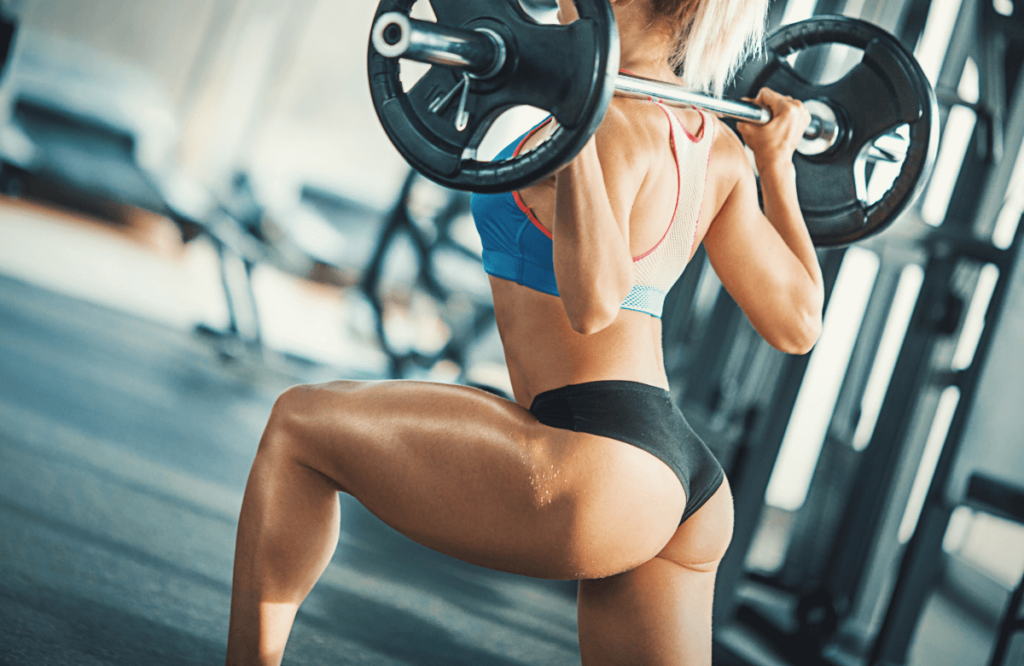
6. Mental Health and Improved Sleep
If you are constantly feeling tired and lack energy, do cardio and lift some weights. Working out will boost the feel-good chemicals in your brain. It helps you to sleep better and just improve your overall quality of life.
Workouts don’t just train the body, they strengthen the mind as well. When you exercise, you can’t just let your mind wander off and expect your body to do the job.
When you train, you have to be very focused on making sure you perform proper form and you are engaging the right muscles. You push yourself to complete all the repetitions and sets. So, this will strengthen your body and also your mind.
You will also experience the benefits of the gym. That’s the focus, better memory, and increasing self-belief. And you will adapt to different situations better.
Exercising will make you athletic and give you more confidence. It makes you feel stronger and you will know that you can do your daily fitness routines such as carrying grocery bags, your children, and lifting other heavy items on your own without needing someone else’s help.
7. Boost Energy and Mood
Many people don’t seem to feel like they can fit exercise into their daily schedules. Balancing everything sometimes becomes very hard.
You may feel everything piling up and the thought of going to the gym feels unfathomable. You are overwhelmed and feeling anxious and your mental health is suffering. All you can think about is how so many things are piling up and your lack of time to complete it all.
What you may not know is that even taking out 30 minutes 5 times a week to do some form of physical exercise can be of great benefit to your mental health and well-being.
How It Works
Your brain recognizes exercising as a moment of stress. Your body releases chemicals called endorphins to fight the stress. These hormones interact with opioid receptors in the brain. The binding of these opioid receptors can boost mood by reducing pain perception and therefore causing a more positive feeling in the body.

Runner’s High
You may have heard of the term runner’s high which refers to the feeling of euphoria that some individuals feel after a run. This can be accompanied by an energizing and positive outlook on life.
Running has been seen to reduce feelings of anxiety and depression. It also boosts self-esteem, improves sleep, and reduces stress. All these can have a positive impact on one’s mental health.
Research
A study showed that participants practicing physical activity at recommended levels were associated with fewer anxiety symptoms by 71%.
Participants took a standard self-administered questionnaire to measure their level of physical activity per week. They were categorized based on whether they met the current recommendations on physical activity which was at least 30 minutes a day 5 times per week of moderate-intensity exercise.
Participants who reported moderately energetic physical activity of 2.5 hours a week were considered to have a sufficient level of physical activity. An anxiety symptoms score was derived from a 30-item General Health Questionnaire.
8. Stress Relief
For some people, stress is simply a part of life. Figuring out ways to manage your stress is important. Exercise can be best described or defined as the beautiful movement of the body. The practice of exercise in a person’s life works to promote a sense of well-being and improve health.
Exercise can lower stress, blood pressure, improve sleep, and reduce the risk of depression. After a few weeks of consistent exercising, you will begin to feel better, less stressed, and much happier throughout the day.
The American Journal of Preventive Medicine did a systematic review that showed physical activity as a method for preventing the onset of symptoms of depression. Out of 30 reviewed studies, 25 showed that individuals who exercise were at low risk for depression.
So, these are 8 benefits that you will experience once you start exercising. There are so many other benefits such as heart health, preventing diseases, living longer, and looking younger.
1-Month Workout Results: Before and After Male Transformations
Mike
Devon Meiring
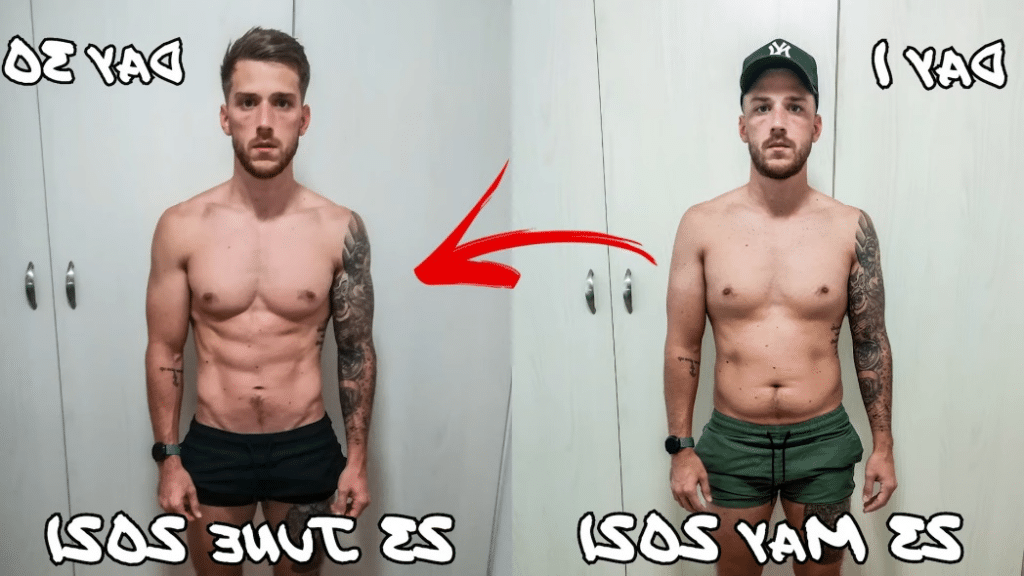
Khan Omair
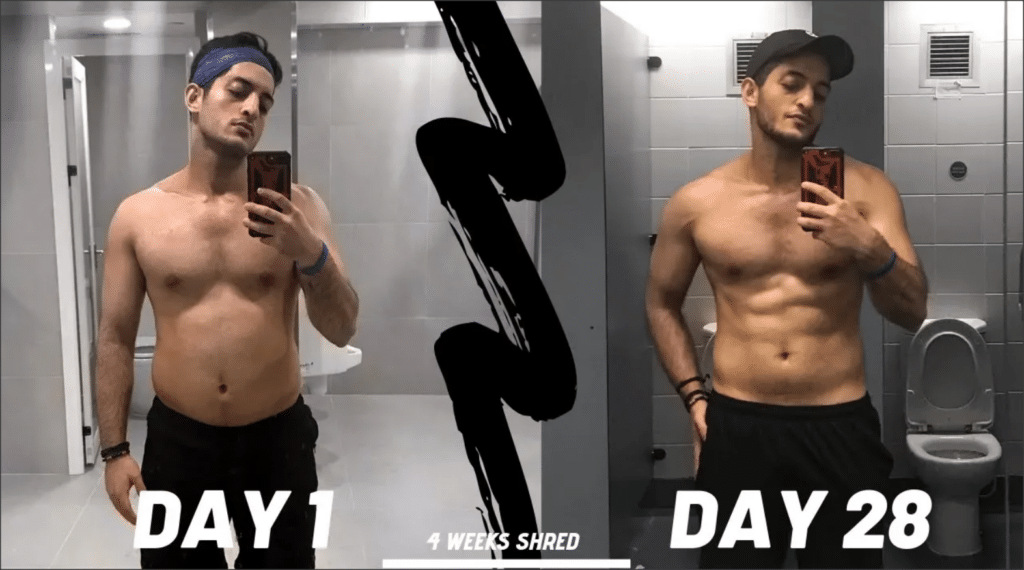
1-Month Workout Results: Before and After Female Transformations
Shay Mitchell
From 193 to 152 pounds in 1 month

Cara Pyper

Adriana Marie

Factors Affecting Your 1-Month Workout Results Before and After
Let’s talk about factors that influence how people respond to exercise and the results they will experience.
1. Age
Your physical fitness tends to peak in the twenties and early thirties and decrease thereafter. Although this decline can be offset by regular exercise, as we age, active muscles get weaker, joints become stiff, hormone levels decline and reflexes slow and body fat levels increase. After 30, people are also less tolerant of high-intensity and high-volume exercise.
2. Gender
Men have more testosterone than women and as such a great potential for muscle mass and strength. Women tend to be naturally more flexible than men because of their relaxing hormones. However, both men and women can develop impressive levels of strength and be very flexible with the correct body training.
3. Body Type
The body type of an individual will have a profound effect on their ability to develop fitness. For example, a naturally-muscular, heavily-built person is better suited to rugby than long-distance running.
The system for classifying body types is called somatotyping. Although, it is important to note that most people are made up of a mixture of three main body types: Ectomorphs, Mesomorphs, and Endomorphs.
Ectomorphs are naturally slim with narrow shoulders and hips. They usually find gaining weight very difficult. They are more suited for cycling and running where the light bodies will be an advantage.
Mesomorphs tend to be naturally lean and muscular. They usually are athletic and strong with wide shoulders and narrow waists.
Endomorphs are usually apple or pear-shaped but despite high body fat levels, they are usually reasonably muscular. Weightlifting is a good activity for them.

4. Diet
To adapt to exercise, the body needs a broad range of nutrients including protein, carbohydrates, fat, vitamins, and minerals. A bad diet can affect weight loss and muscle gains.
5. Activity Level
A few hours of exercise a week will not be enough to develop a good level of fitness if you are not active for the other 165 hours. And also the opposite, if you are too much active that you’re not able to recover from the training session, you will not experience any improvements in terms of fitness.
6. Illness and Fatigue
Illness and tiredness can diminish physical performance as well as interfere with not only exercise but with the recovery from the exercise. And in some cases, too much training (overtraining) can cause illness and fatigue.
7. Stress
Stress increases the production of the breaking-down cortisol hormone and can also cause an increase of blood pressure as well as the risk of heart disease and trigger stress eating. So, stress can have very bad effects on your 1-month workout results before and after.
8. Environment
Water, food, and airborne toxins can have really bad effects on health and fitness. Fumes from traffic, high altitude, and weather can also affect exercise intensity and duration.
9. Skill, Technique, and Muscle Power
These factors affect your short-term performance. Skill and technique are essential because you need to have efficient movement patterns and you need to practice those patterns. You don’t have to do them always under heavy loads.

Our Tips for Maximizing Your 1-Month Workout Results Before and After
Let’s talk about how to get the most out of your workouts. When it comes to exercising, many people want to get the most out of their time and effort. Whether you’re looking to build muscle, lose weight, or simply improve your overall health, there are several ways you can maximize your workouts.
Here are our tips that will actually help you improve your 1 month workout results before and after.
1. Lift Weights
Resistance training is one of the most effective ways to build muscle mass and increase strength. By lifting weights, you create micro-tears in your muscle fibers which your body then repairs and strengthens. This can help you to burn more calories even when you are not exercising because muscle tissue burns more calories than fat tissue.
Additionally, strength training can help prevent injuries and improve your overall health and fitness.
2. Eat Carbs Before Working Out
Carbohydrates are your body’s primary source of energy. Eating carbs before your workout can provide your muscles with the energy they need to perform at their best.
Aim to consume a meal containing carbohydrates and protein at least two hours before your workout. Always choose complex carbs such as whole grains, fruits, and vegetables rather than simple carbs like candy or soda.
3. Drink Water
Staying hydrated is important for optimal performance during workouts. Water helps regulate your body temperature, transport nutrients to your muscles, and remove waste products from your body. Aim to drink at least 8 ounces of water before and after your training session. And drink water throughout your workout as needed.
4. Get a Good Night’s Sleep
Sleep is essential for muscle recovery and growth. Lack of sleep can negatively impact your workout performance and slow down your progress. Target at least 7-8 hours of sleep each night.
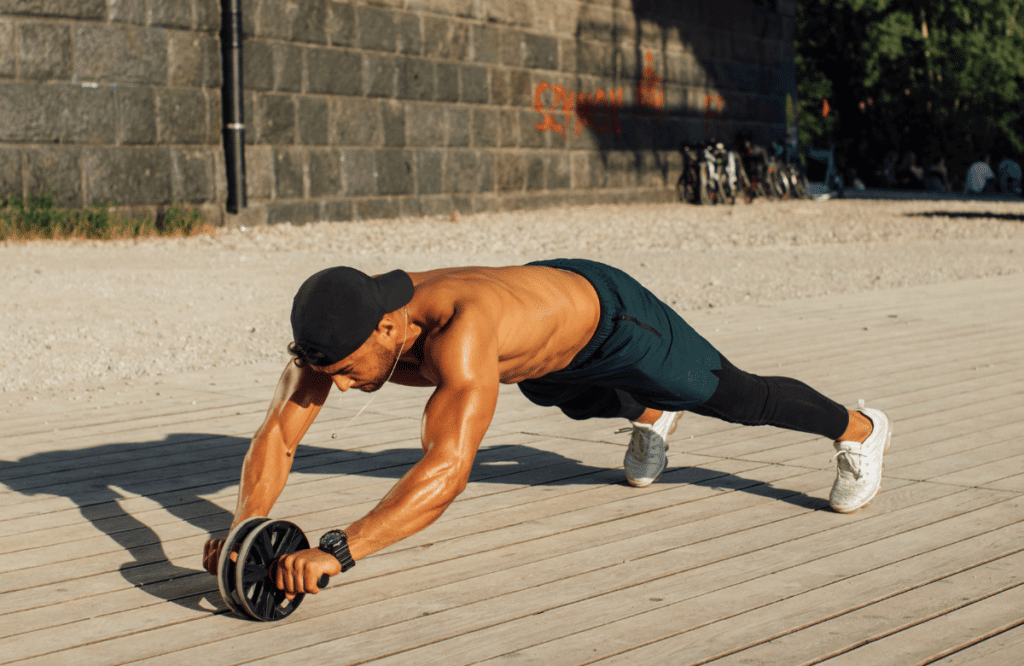
5. Do Some Physical Activity Every Day
Although our lives are busy and overwhelming and it seems like we don’t have the time to take out for exercise, it can actually help with the feelings of anxiety that many people feel due to life stress.
This isn’t saying that exercise is a cure for poor mental health. But it is a recommended healthy coping mechanism for when you may be having these feelings of stress and anxiety and are not sure how to cope.
Taking out some time out of your day to do exercises may seem hard. But remember that physical activity does not have to mean going to the gym.
There are so many ways to keep up with physical activity. It could be going out for a hike, a brisk walk on the street, a jog, riding your bike, walking up and down the stairs, or even having a dance party in your room in front of the mirror.
As soon as you find the form of physical activity that can fit into your life, you’ll find it a lot easier to take out those 2.5 hours a week that can make all the difference.
6. Try Dynamic Warm-Ups
Dynamic warm-up exercises are a series of movements that prepare your body for exercise by increasing your heart rate and loosening your muscles. They can help to improve your flexibility and range of motion and reduce your risk of injury.
7. Increase Your Protein Intake
Protein intake is essential for repairing and building muscle tissue. Consuming protein before and after your workout can help to increase muscle growth and improve recovery time.
Aim to consume at least 20 to 30 grams of protein before and after your workout. You can consume protein through food sources such as chicken, fish, and tofu or through protein supplements such as protein shakes.
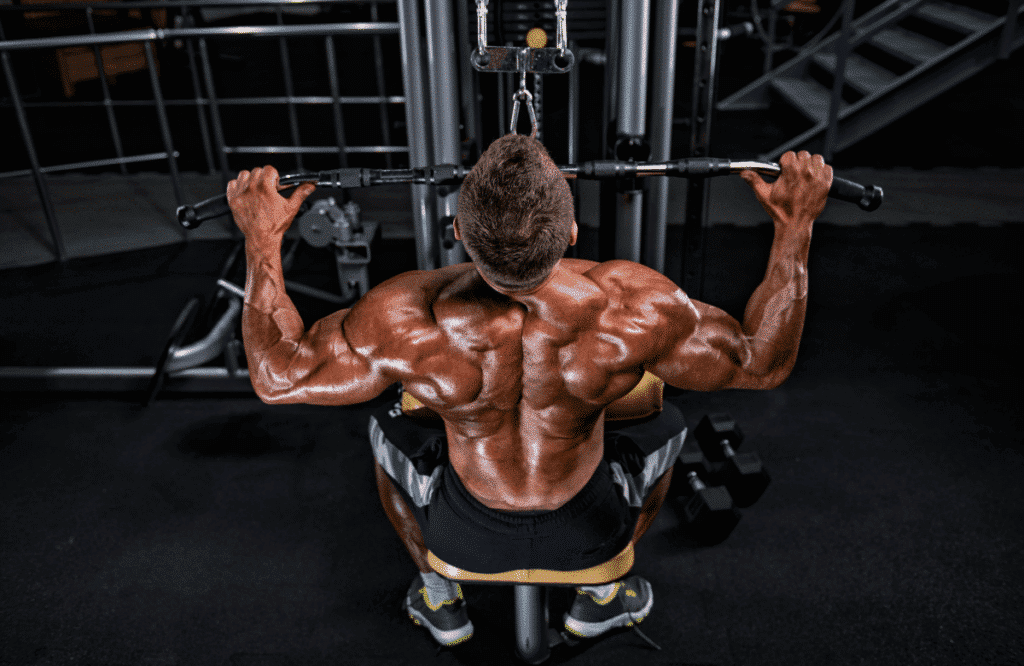
8. Focus on Compound Exercises Instead of Isolation Exercises
Compound exercises are exercises that work multiple muscle groups at once such as squats, deadlifts, and bench presses. On the other hand, isolation exercises work only one muscle group at a time such as bicep curls or triceps extensions.
By focusing on compound exercises you can maximize your workout time and burn more calories. Additionally, compound exercises can help improve your overall strength and fitness.
9. How to Start
Start by doing total body strength training three times weekly on alternate days. On the other days, you can perform cardio exercises. It takes between 24 to 48 hours for our muscles to build and recover. So, avoid training the same muscles. Consecutively exercising and allowing your muscles to recover is equally important.
Each weight training session should last for 45 to 60 minutes. And when you lift remember that the weights should be enough for you to perform between 8 to 15 repetitions. If you can do more than 15 repetitions without much of a struggle, then the weights are too light and you need to lift heavier. Start with three sets per exercise and slowly increase to four sets.
However, there isn’t one right way to exercise. There are many different types and kinds of exercises that you can try. You may find that you like biking or yoga or maybe you enjoy running or strength training. Finding ways to move your body in ways that you enjoy is key to lowering stress and gaining the many benefits of exercise.

1-Month Workout Results Before and After: FAQs
Can you see results after 1 month of working out?
You can definitely get some benefits even after 1 day of working out. However, keep in mind that there are a lot of factors affecting your 1-month workout results before and after.
Generally, there are two types of factors: skill-related and health-related. Skill-related factors are agility, balance, coordination, power, and reaction time. Health-related factors are cardiovascular fitness, muscular strength, and muscular endurance. Other factors: diet, alcohol, and smoking.
Is working out 15 days a month enough?
Generally, 12-15 training sessions on a monthly basis or 3-4 workouts per week are a sufficient volume of training for beginners. If you work out and maintain a proper diet for a month, you will tailor your fitness journey effectively and reach your weight loss goals.















